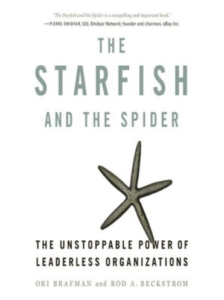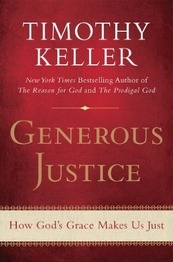The Starfish and the Spider
by Ori Brafman and Rod Beckstrom
This is one of those books that I put in my top ten because it crystalized principles that we continue to put into practice. Our church, called LifeNet, morphed from being a centralized spider organization called Liberty Church into a decentralized starfish. We did this at the leading of the Holy Spirit before I ever read the book, but reading the book helped me to connect the dots.
Most successful starfish organizations were started with what seemed at the time to be a radical ideology. Brafman, Ori; Beckstrom, Rod A.. The Starfish and the Spider (p. 206). Penguin Publishing Group. Kindle Edition.
The “radical ideology” behind LifeNet is the notion that churches work better as small groups. I use quotation marks because this is how the church began in the Book of Acts, but because the institutional church drifted so far from its beginnings, it seems radical today to many. For us it meant jettisoning our building and launching into the uncharted waters of existing only as a confederation of small groups, which we legally named Life Community Network, or LifeNet for short.
The overall concept of the book is quite simple: centralized hierarchical organizations can be “killed” by taking out the head, as with a spider, but decentralized organizations only morph and multiply when attacked, as with starfish. You can cut off the arm of a starfish and another starfish will grow out of that arm. The authors compare the Aztecs, a centralized nation, to the Apaches, a decentralized group. The Aztecs were easily conquered by the Spanish by defeating the central government in the capitol city, but the Spanish could never defeat the nomadic Apaches, who did not have a central government, followed charismatic leaders, and could vanish into the wilderness when their villages were attacked. Interestingly, the church in China has thrived under persecution because it too is a decentralized network of small groups.
As might be expected, the book extensively compares centralized organizations to decentralized ones. It praises the advantages of decentralized starfish organizations, while acknowledging that both have their place. The authors even examine the advantages associated with combining elements of both to form hybrid organizations, such as eBay and Toyota. This echoes the ideas found in another important church book entitled And: The Gathered and Scattered Church, of which I have written a summary.
The principles contained in the book are readily transferable to the church setting, as was the case with other business books I have read over the years. (Eg. The Answer to How Is Yes by Peter Block is one of the best books on faith out there. You can click on the link above to read my summary.) Small group based churches, such as LifeNet, can profit by understanding the nature of being an effective starfish organization. I believe this was part of the genius of the early church.
Centralized organizations rely heavily on top-down decision making. Everyone beneath “upper management” must obey the directives coming down from the top, ensuring uniformity. Decentralized organizations disperse decision-making authority among multiple people or departmental teams. Individuals at a “lower level” approve decisions and then report them to personnel in “upper” management.
Decentralized organizations rely heavily on everyone buying into the same vision and maintaining open lines of communication. However, unity at the vision level does not guarantee or expect unity at the application level.
That is part of the genius of the decentralized organization. Great freedom is given to “lower” leaders to experiment and implement innovative ideas.
At LifeNet, we see ourselves as a decentralized network of small groups, which are led by, in our case, elders. As we grow larger, not all small group leaders will be elders, but they will all be pastors or shepherds – people who care about people.
The board of elders generally oversees the entire network without dictating to each small group leader exactly how to implement the vision.
Each leader has been given freedom to lead his or her group within the overall vision of the Great Commission – sharing the gospel and making disciples. How this is done varies from group to group, but the Great Commandment – loving God, one another, and our neighbor – is always at the forefront. We rely upon the Holy Spirit to guide us and to keep us from veering off into some form of legalism. We depend on the Bible to keep us from error.
We realize that true discipleship is a result of individuals making a personal commitment to follow Christ. The church exists to inspire, equip, and encourage such people on their journey.
Understanding the difference between the role and function of CEOs, catalysts, and champions is important. Catalysts are perhaps the least understand and most important. They are the ones with the vision and are critical in the creation and success of starfish organizations. The champion is the person most visible to those on the outside. Usually they are the public “face” or “mouth” of the organization, the one best equipped to share the vision and rally others to the cause. People on the outside see champions as the true leaders, not realizing that the catalyst is actually the “heart and soul” of the group. CEOs are the people gifted to bring a minimalist type of structure to the organization that will allow it to grow without losing the genius of decentralization. (See my summary of Organic Church for more on this concept.)
Most decentralized organizations become increasingly centralized over time.
This is also true for the church. History records how the early church grew and gradually adopted centralization, which was the beginning of its deterioration, which became so great that it required the Reformation centuries later to get it back on track.
The more power, authority, and wealth accrues to those who govern the overall organization, the more difficult it becomes for them to distribute decision-making authority.
The Methodist movement, which began as a decentralized organization, eventually became a top-down denomination that has gone off the rails doctrinally – too much power in the hands of the wrong people. The nation of Israel began as a decentralized confederation of tribes governed by Holy Spirit appointed judges who ruled for a season, but a desire to be like other nations drove the people to adopt a centralized government run by a dynastic king. This was because they grew weary of trusting God to raise up new judges. They wanted a permanent institution. The United States also began as a decentralized confederation of states but over time granted more and more power to a strong federal government which basically stripped the states of their original autonomy and power.
I believe their is an inherent drive in mankind to move toward centralization. I call it the Babel Principle, about which I have written elsewhere.
The motive behind this bent is that we do not like being continually dependent upon God for direction. We would rather build a system for self-government, even though it always tends toward corruption. Relying upon the Spirit to give direction continually and raise up new leaders to replace ones we have looked to in the past is challenging and exposes us to uncertainty, but that is exactly the environment in which we grow in our relationship and faith in God.
This may be the most important reason why decentralization is so good. It requires us to always rely on God.
This book is challenging, fascinating, informative, and practical. I hope you will take time to read it and ponder its message.




